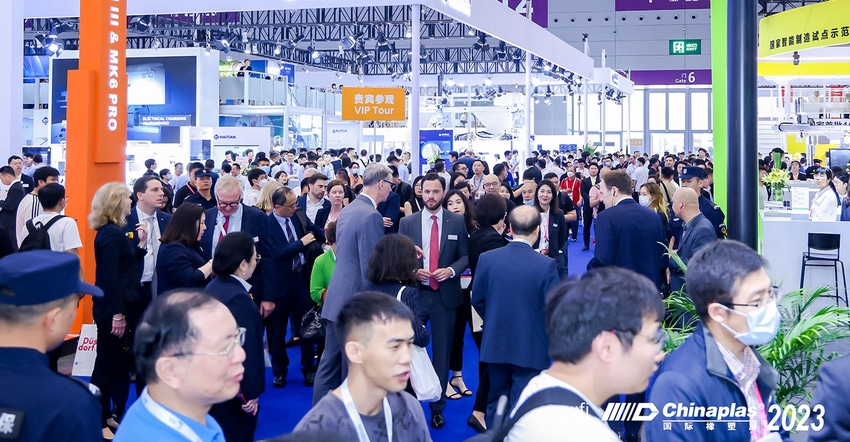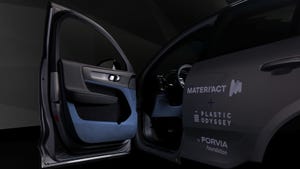There was an extensive extrusion section at Chinaplas. Language is always a barrier, but so are machine automation and precision requirements.
May 14, 2023

Chinaplas ran from April 17 to 20 in Shenzhen, a very big city with a population of 13 million in the metro area and many plastics companies. Show organizers reported more than 250,000 visitors, which is the K in Düsseldorf, Germany, at its zenith. I’ve been to a lot of K shows, which typically run eight days — Chinaplas was just four days.
China announced that it would require attendees to show proof of being quarantined against COVID-19, but the authorities did not check on site, as far as I know. China hasn’t declared the pandemic over, unlike in much of North America and Europe, where the issue became political. Frisky riskies and science deniers want no restrictions in the name of freedom, and people run around maskless in the name of comfort, as if nothing happened. I’m old enough to be high risk, and enough of a scientist and realist not to believe just what I want to be true. I still avoid groups of people indoors, but with less anxiety than before. I'm glad I didn't have to navigate the crowds at Chinaplas.
That 250,000 is a lot of people, but I don’t see much to worry about. Not all the exhibitors were Chinese, and the exhibitor list includes some familiar non-Chinese names. Most visitors were Chinese — surprisingly, only around 10% were foreign — and some of the 250,000 may have been the same people counted anew each day. You can learn more at www.chinaplasonline.com, including pages of the daily magazine in English. It will take time, but much less than a trip to China.
Quick profit versus investment
There was an extrusion section, with further division into film, profile, and blow molding. Language is always a barrier. Another barrier is the degree of automation and precision, which is related to the ease and cost of internal recycling and acceptance of internal scrap. This is a business issue, as it relates to sales security and the conflict between a quick profit and investment.
North American and European extrusion equipment can be highly automated, but machine cost can still be a small percentage of manufacturing costs — 10% if used on a 24/5 cycle or more, maybe less for some high-cost plastics, especially if responsibly amortized and maintained. Watch drive motor power in all but the smallest lines, as that may link to cost per lb/kg produced. But we can’t assume that by producing more, more will be sold. And does most of what’s produced in China stay in China?
Materials management in the extrusion process
As for technology, I’m spoiled by the desire for real-time process measurement, and knowledge and management of materials. Everyone can do these things now, but they require time and talent. Easy to say, harder to do: Buy in large lots, with known and consistent particle sizes and shapes, and know everything that’s in them, including why and how much. Be able to add ingredients at the extruder like antioxidants to allow reuse of more scrap/trim while keeping critical properties as good or better than virgin. Or the addition of UV absorbers, if the product is to be used or stored outdoors. That’s what I mean by materials management.
It's sometimes cheaper to trust suppliers to provide the properties that matter, so you don’t have to know what’s there, but you can still test those properties and make them the requirements.
At Chinaplas, 90% of the attendees came from within China, which reminded me that it’s a very big place, and its own consumption is the driving force of the show. Yes, some of this ends up in other countries, and this interdependence needs market and economic stability to work well. Plastics contribute much to this stability.
Look beyond machinery brand names
Machinery was on display, of course, and some will cost less than it does in Europe or the United States (also represented on the show floor), but extruders and molding machinery are more than just brand names and need specifications and data commitment, too. An extruder is only the beginning of a production line, and its cost must include feeding and storage, which depend on volume, forming, and safely cooling and holding the product. Watch motor powers, line speeds, and consistency. Five ft/lb of a product may be reasonable to expect, but not without knowing material and dimensional variations. Know needed energy per kW and max melt temperatures. Today we can see a lot on recorded data, video, and photos, so there is good reason not to make rash decisions. Don’t forget payment terms, including timing, currency, trial runs, delivery, installation, and performance. Language matters, and sometimes two are needed. And don’t forget communication with makers and their agents — distance/time may matter less than materials, with a few exceptions. It’s like married children that live far away — e-mail or texts to service partners are desirable.
This is my personal view, and I expect a few people to say, “But I did it and it paid off for me.” In my defense, I am not a risky frisky and prefer to make and sell products that perform better, weigh less, and save money that way. Because of my tech background, that’s my comfort zone.

Allan Griff is a veteran extrusion engineer, starting out in tech service for a major resin supplier, and working on his own now for many years as a consultant, expert witness in law cases, and especially as an educator via webinars and seminars, both public and in-house, and now in his virtual version. He wrote Plastics Extrusion Technology, the first practical extrusion book in the United States, as well as the Plastics Extrusion Operating Manual, updated almost every year, and available in Spanish and French as well as English. Find out more on his website, www.griffex.com, or e-mail him at [email protected].
No live seminars planned in the near future, or maybe ever, as his virtual audiovisual seminar is even better than live, says Griff. No travel, no waiting for live dates, same PowerPoint slides but with audio explanations and a written guide. Watch at your own pace; group attendance is offered for a single price, including the right to ask questions and get thorough answers by e-mail. Call 301/758-7788 or e-mail [email protected] for more info.
About the Author(s)
You May Also Like




